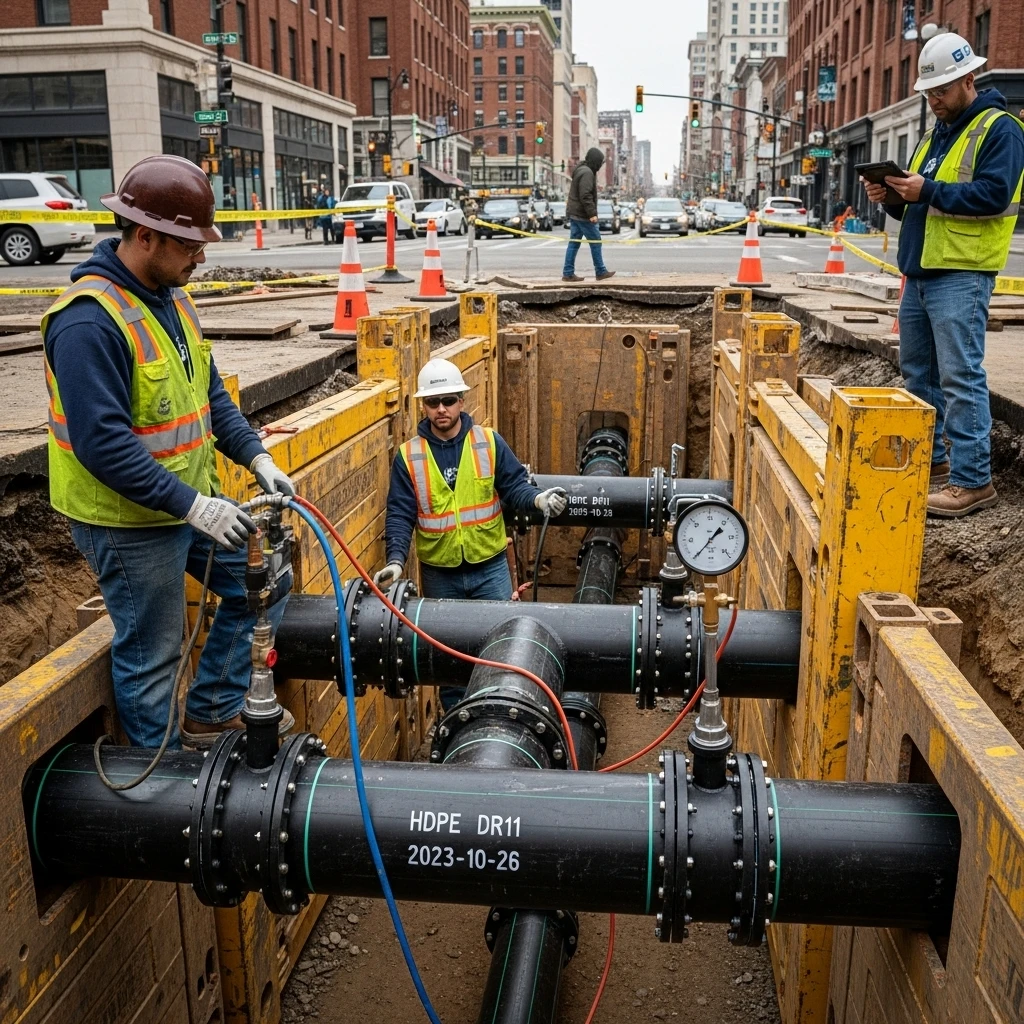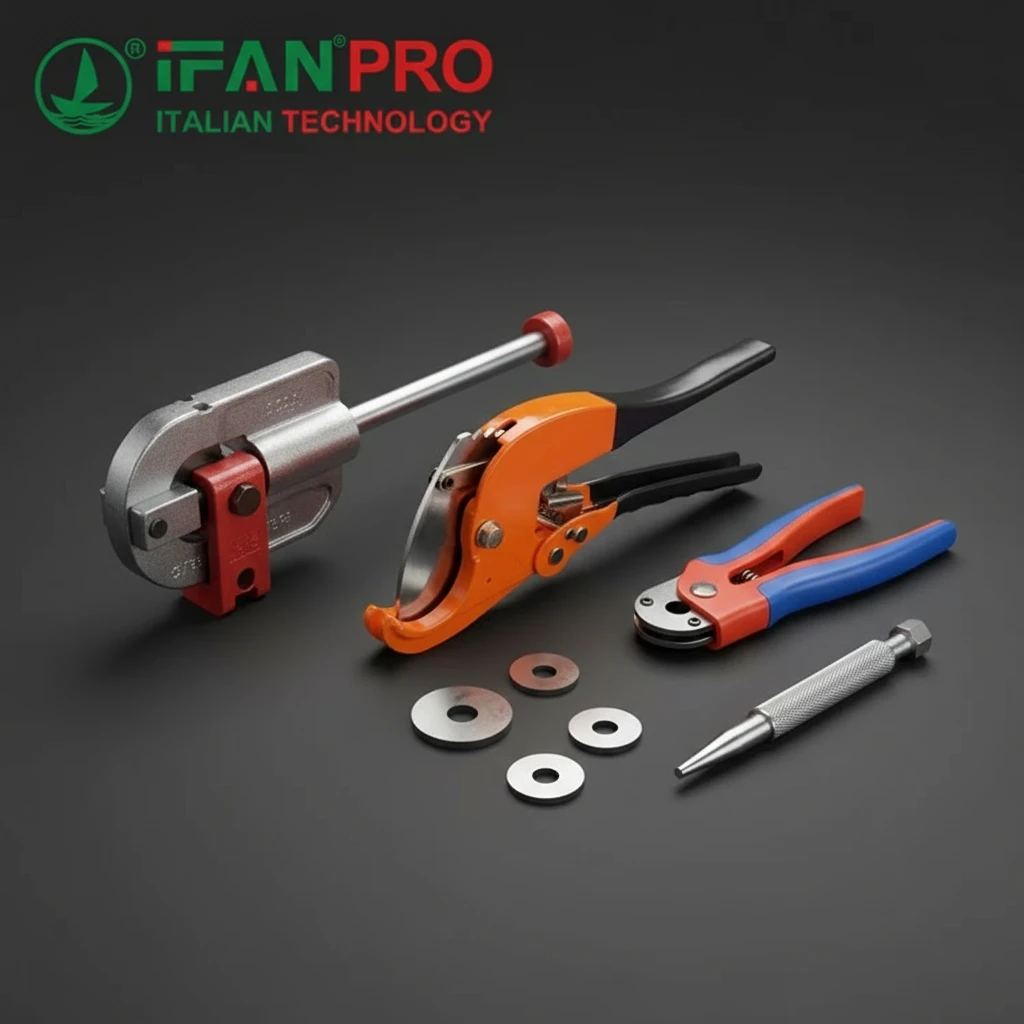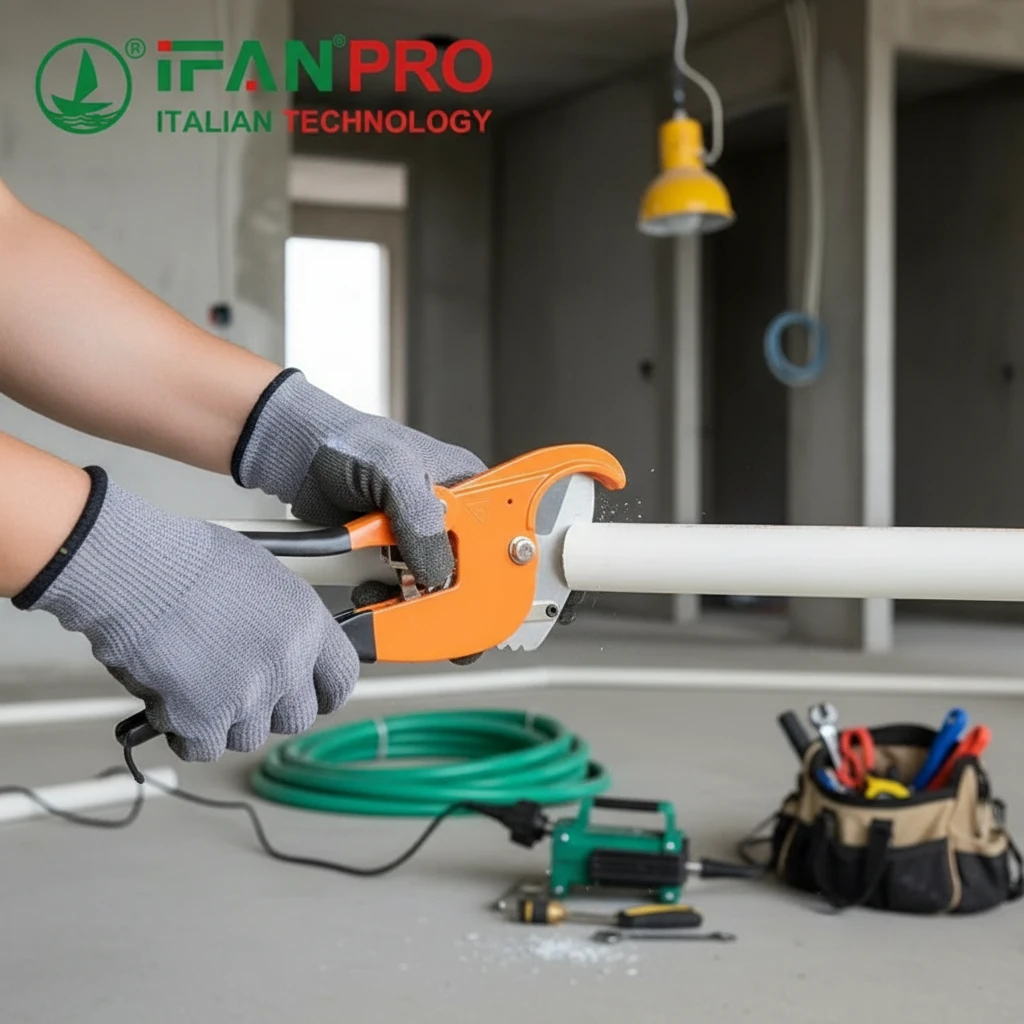I’ve watched countless plumbing systems fail over the years, but ПНД consistently stands the test of time. Homeowners and contractors choose HDPE because they need pipes that won’t let them down.
High-Density Polyethylene (HDPE) pipe can last over 50 years when installed correctly in appropriate applications. This longevity is due to its resistance to corrosion, chemicals, and environmental stress. Many manufacturers and studies confirm this 50-year lifespan when the pipe meets specified conditions, such as proper pressure ratings and installation quality.
While the 50-year benchmark is common, the actual lifespan of your HDPE piping depends on several factors we’ll explore below.
What Factors Determine the Actual Lifespan of HDPE Piping Systems?
I’ve seen HDPE pipes last for decades without issues, while others fail prematurely. The difference often comes down to a few key factors.
The actual lifespan of HDPE piping is determined by material quality, installation techniques, operating conditions, and environmental stressors. Key factors include the resin quality, fusion joint integrity, internal pressure loads, temperature extremes, chemical exposure, and UV protection. Properly addressing these elements ensures the pipe reaches its maximum service life.

Material Quality and Manufacturing Standards
Not all HDPE pipes are created equal. The base resin quality fundamentally affects how long your pipe will last. Premium HDPE resins like PE100 provide superior stress crack resistance and long-term strength. When material contains consistent, high-quality polyethylene with proper carbon black distribution (typically 2-2.5%), it gains crucial UV protection for outdoor use .
Manufacturing standards also play a critical role. I always check for proper certifications like ISO 4427 for PE100 pipes, which ensures the material meets minimum strength and durability requirements. The oxidative stability (often measured through Oxidative Induction Time or OIT) indicates how well the resin resists degradation over time. Lower quality materials with inconsistent carbon black distribution or filler additives will degrade faster.
Operating Conditions and Stress Factors
Your operating conditions directly impact how long the pipe will last. Constant pressure variations, water hammer effects, and temperature cycling all contribute to material fatigue. HDPE’s resistance to slow crack growth is excellent, but under constant high stress (approaching its pressure rating), the lifespan can shorten considerably.
Chemical exposure is another crucial factor. While HDPE resists most chemical attacks better than metals, strong oxidizing acids, chlorinated solvents, and certain hydrocarbons can permeate the material over time, potentially reducing its lifespan. The pipe’s wall thickness, determined by its DR (Dimension Ratio) rating, affects its resistance to both pressure and chemical permeation.
Critical Factors Affecting HDPE Pipe Lifespan
| Factor | Impact on Lifespan | Optimal Conditions |
|---|---|---|
| Качество материала | High-quality PE100 resin can last 50+ years | PE100 with proper carbon black content |
| Installation Quality | Proper fusion joints can outlast the pipe itself | Trained technicians using correct procedures |
| Operating Temperature | Each 10°C increase can halve lifespan in pressure applications | Below 20°C for longest life |
| Chemical Exposure | Most chemicals have minimal effect; some solvents cause swelling | Neutral pH, no strong oxidizers |
| UV Exposure | Unprotected pipes degrade in 5-10 years | Proper carbon black distribution or burial |
Recent research emphasizes that tensile elongation and oxidation induction period are the most sensitive indicators for predicting HDPE pipe service life . Monitoring these parameters through the pipe’s life helps utilities plan replacements before failures occur. Understanding these factors helps explain why the same pipe material might last 30 years in one installation but 70 in another.
How Does HDPE Pipe Durability Compare to Traditional Pipe Materials?
Having worked with all major pipe materials, I can confidently say HDPE outperforms most traditional options in typical residential and municipal applications.
HDPE pipe significantly outlasts many traditional materials, typically lasting 50+ years compared to 20-50 years for metals and concrete. It completely resists corrosion that destroys iron pipes, doesn’t support scale buildup that constricts metal pipes, and maintains flexibility that concrete lacks. This longevity advantage makes HDPE more cost-effective despite potentially higher initial cost.

Direct Comparison with Metal Pipes
The corrosion resistance of HDPE creates its biggest advantage over metal pipes. While steel and iron pipes rust from both inside and outside, HDPE remains unaffected by electrolytic corrosion, rust, or tuberculation. This means HDPE maintains its full bore diameter and flow capacity throughout its life, while metal pipes gradually lose capacity to scale and corrosion.
I’ve documented cases where iron pipes needed replacement after 20-30 years due to corrosion, while HDPE installations from the same period showed no signs of degradation. The corrosion factor is particularly important in areas with aggressive soils or corrosive water conditions where metal pipes might fail in just 10-15 years.
Advantages Over Other Plastic Pipes
While PVC is another common plastic pipe, HDPE offers several durability advantages. HDPE has superior fatigue resistance, handling repeated pressure surges better than PVC. Its flexibility allows it to withstand soil movements and minor settlements that would crack rigid PVC pipes. Most importantly, HDPE maintains better impact resistance at low temperatures, where PVC becomes brittle.
The jointing method represents another significant advantage. While PVC uses solvent cement joints that can be vulnerable to installation errors, HDPE’s heat-fused joints create monolithic connections that are as strong as the pipe itself. This eliminates the joint failures I commonly see in other plastic piping systems.
Lifespan Comparison Table
| Pipe Material | Typical Lifespan | Failure Modes | Maintenance Requirements |
|---|---|---|---|
| ПНД | 50+ years | Slow crack growth, oxidation | Minimal, mostly inspection |
| Copper | 40-50 years | Corrosion, pitting, theft | Joint repairs, corrosion control |
| PVC | 25-40 years | Brittle fracture, UV degradation, joint failure | Replacement of broken sections |
| Galvanized Steel | 20-50 years | Internal rust, scale buildup | Descaling, leak repairs |
| Concrete | 30-70 years | Chemical degradation, joint failure | Lining, joint rehabilitation |
Economic Implications of Longer Life
The extended lifespan of HDPE creates substantial economic advantages. When we calculate life-cycle costs rather than just initial installation expenses, HDPE typically proves more economical. The reduced maintenance needs, lower pumping costs (from maintained flow efficiency), and elimination of lining or replacement projects make HDPE the cost leader for long-term applications.
One study noted that compared to steel pipes, HDPE reduced life-cycle costs by approximately 30% when accounting for installation, maintenance, and expected service life . For municipal systems with limited budgets, this long-term value often outweighs higher initial material costs.
What Environmental Conditions Affect HDPE Pipe Longevity the Most?
Through years of field experience, I’ve identified which environmental factors truly threaten HDPE pipes and which are minor concerns.
HDPE pipe longevity is most affected by ultraviolet radiation, extreme temperatures, chemical exposure, and oxidative environments. UV exposure causes surface degradation, temperature extremes affect pressure capacity, certain chemicals cause environmental stress cracking, and oxidation leads to material embrittlement over decades of service.

Ultraviolet Radiation Exposure
Sunlight represents the most significant threat to above-ground HDPE installations. UV radiation breaks down the polymer chains at the molecular level, causing surface embrittlement and cracking. However, properly formulated HDPE with 2-2.5% carbon black pigment provides excellent UV protection .
Unprotected HDPE pipes may show significant degradation after 5-10 years of direct sun exposure, while properly compounded pipes maintain their properties for 50+ years outdoors. For critical above-ground applications, I recommend additional UV protective coatings or wraps, particularly in high-sunlight regions. Regular inspection for surface chalkiness or microcracking helps identify UV issues early.
Temperature Extremes and Fluctuations
While HDPE performs across a wide temperature range (-60°C to 60°C), extreme temperatures affect its pressure capacity and long-term aging. For every 10°C increase in operating temperature, the maximum sustainable pressure decreases by approximately 15-20%. In constant hot water service at 60°C, HDPE’s pressure rating is roughly half its room-temperature capacity.
More importantly, temperature cycling creates repeated expansion and contraction stresses, particularly in restrained above-ground installations. Over decades, these thermal cycles can contribute to fatigue, especially at mechanical connections or points of restraint. Proper support spacing and expansion loops mitigate this issue.
Chemical and Oxidative Environments
HDPE resists most chemical attacks, but strong oxidizers like chlorine and certain solvents pose the greatest threats. In water treatment applications with high chlorine levels, I’ve observed increased polymer degradation over time. Current research focuses on how these oxidative environments accelerate aging in HDPE pressure pipes .
Soil chemicals generally don’t degrade HDPE, but certain contaminated sites containing hydrocarbons or pesticides may cause environmental stress cracking. This slow crack growth initiates at points of stress concentration and can lead to premature failure. Proper resin selection with high stress crack resistance (PE100 RC) minimizes this risk in potentially contaminated soils.
Environmental Risk Assessment
| Environmental Factor | Risk Level | Impact Timeline | Mitigation Strategies |
|---|---|---|---|
| UV Exposure | High (unprotected) | 5-10 years | Carbon black, protective coatings, burial |
| High Temperature | Medium-High | 10-20 years | Derating, insulation, shading |
| Chemical Exposure | Medium | 10-30 years | Material selection, bedding, monitoring |
| Oxidation | Low-Medium | 25+ years | Antioxidant additives, operating below rated pressure |
| Soil Movements | Low | 15+ years | Proper bedding, flexible joints |
Recent studies show that the induction period of oxidation (IPO) is one of the most sensitive indicators for predicting HDPE pipe remaining life . Monitoring this parameter in older pipes helps utilities plan replacements before failures occur. Understanding these environmental factors helps installers maximize pipe longevity through proper design and material selection.
How Can Proper Installation Extend the Service Life of HDPE Pipes?
I’ve supervised countless HDPE installations, and proper technique separates projects that last decades from those that fail prematurely.
Proper installation extends HDPE pipe life by ensuring correct fusion jointing, appropriate bedding and backfill, protection during handling, and correct pressure testing. Expert fusion creates monolithic joints stronger than the pipe itself, while proper bedding prevents point loading that initiates stress cracks. These installation best practices help the pipe achieve its full 50+ year potential.

Fusion Jointing Techniques
The fusion process represents the most critical installation step. Proper socket fusion requires clean, square pipe ends, correct heating temperature and time, and proper alignment during joining. I’ve found that trained, certified fusion technicians consistently produce superior results compared to untrained workers.
Electrofusion fittings, while convenient, require even more attention to detail. The pipe surface must be properly scraped to remove oxidation, the fitting must be clean and dry, and the fusion cycle must complete without interruption. I recommend documenting each fusion joint with photographs and fusion parameters for quality assurance.
Trench Preparation and Bedding
Proper bedding conditions prevent the point loads that cause stress concentration in HDPE pipes. The pipe trench should have a smooth, compacted bottom free of rocks and debris. For standard installations, I specify 4-6 inches of selected backfill material (usually sand or fine gravel) beneath the pipe to distribute loads evenly.
The pipe zone backfill (6-8 inches over the pipe) should consist of controlled material without large rocks or frozen chunks. Proper compaction in layers prevents future settlement that could leave the pipe unsupported. In unstable soils, I often recommend additional bedding measures like geotextile fabrics or concrete encasement at road crossings.
Handling and Placement Procedures
HDPE’s flexibility makes it easy to install but also vulnerable to installation damage. Dragging pipes across rough surfaces can create scrapes and gouges that become stress concentration points. I require use of proper lifting slings and non-metallic tools during placement to prevent surface damage.
During placement, pipes should not be dropped or subjected to impact loads. The bending radius should be controlled to prevent kinking or ovality. For larger diameter pipes, I often use pulling heads rather than gripping the pipe directly with tension equipment that could damage the pipe wall.
Installation Quality Checklist
| Installation Phase | Critical Procedures | Quality Indicators |
|---|---|---|
| Pre-Installation | Material verification, storage protection | Undamaged pipe ends, clean fusion surfaces |
| Trench Preparation | Bedding compaction, trench width | Smooth bedding, proper depth, shoring |
| Fusion Jointing | Parameter control, alignment, cooling | Consistent bead, proper alignment, no gaps |
| Backfilling | Layer placement, compaction control | Proper density, no voids, minimal settlement |
| Testing & Commissioning | Pressure testing, flushing, disinfection | Test success, clean water, no leaks |
Post-Installation Protection
Even after proper installation, certain protections extend pipe life. Installing warning tape and marker balls above the pipe prevents future excavation damage. For above-ground installations, I recommend UV protection and proper support spacing to prevent sagging and stress concentration.
Commissioning procedures also affect long-term performance. Flushing at proper velocities removes construction debris, while gradual pressurization allows the pipe to adjust to operating conditions. I always document the as-built installation conditions, including fusion parameters and bedding details, for future reference during maintenance or system expansions.
Заключение
ПНД pipe’s 50+ year lifespan makes it an excellent choice for residential and municipal plumbing systems. For your next project, consider IFAN’s HDPE piping products to ensure decades of reliable service. Contact us today to discuss how our HDPE solutions can meet your specific needs.














Последние комментарии